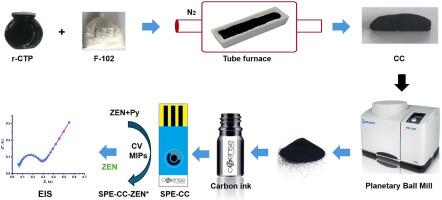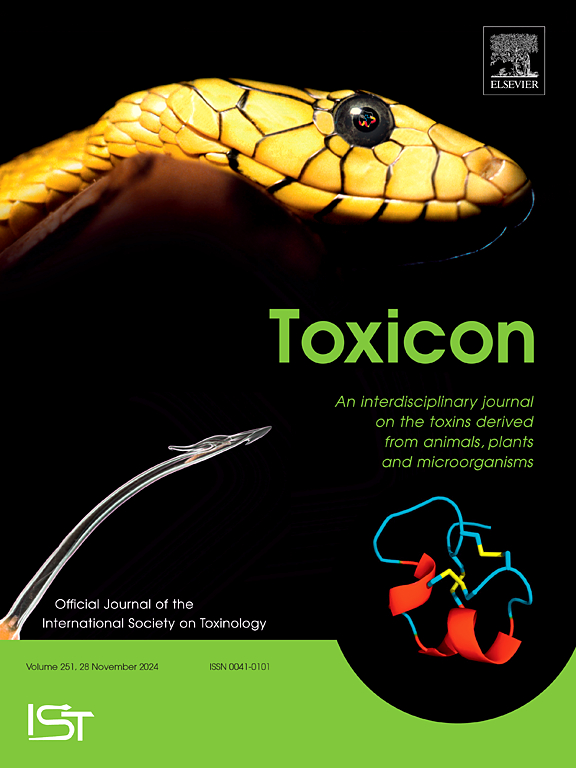An impedimetric determination of zearalenone on MIP-modified carboceramic electrode
IF 2.6
4区 医学
Q2 PHARMACOLOGY & PHARMACY
引用次数: 0
Abstract
Zearalenone (ZEN) is a mycotoxin that poses significant risks to human and animal health due to its mutagenic, immunosuppressive, and carcinogenic properties. This study presents a novel analytical method for detecting ZEN using electrochemical impedance spectroscopy (EIS) combined with a molecularly imprinted polymer (MIP). ZEN, used as the template molecule, was incorporated into polypyrrole on screen-printed electrodes (SPE), and a ZEN-sensitive MIP sensor was created through template removal. The modified sensor surfaces were characterized by EIS and scanning electron microscopy (SEM). An impedimetric MIP sensor for ZEN was developed, offering a detection range from 1 pM to 500 pM. The method's limit of detection (LOD) was established at 1 pM (0.3 pg/mL) with a signal-to-noise ratio of 3 (S/N = 3). The method demonstrated high precision and accuracy, with a maximum relative standard deviation (RSD) of less than 4.4% at a 95% confidence level, and relative error (RE) values ranging from −0.8% to −2.7%. The selectivity of the developed MIP sensor was evaluated using ochratoxin A, ochratoxin B, and aflatoxin B1, with no significant interference observed. ZEN recovery from spiked samples was between 95% and 105%, indicating that the method was successfully applied to grain samples, including corn, rice, and wheat.

MIP 改性碳陶瓷电极对玉米赤霉烯酮的比色法测定
玉米赤霉烯酮(Zearalenone,ZEN)是一种霉菌毒素,具有致突变、免疫抑制和致癌等特性,对人类和动物健康构成重大风险。本研究提出了一种利用电化学阻抗光谱(EIS)结合分子印迹聚合物(MIP)检测玉米赤霉烯酮的新型分析方法。以 ZEN 为模板分子,在丝网印刷电极(SPE)上将其与聚吡咯结合,然后通过去除模板创建对 ZEN 敏感的 MIP 传感器。通过 EIS 和扫描电子显微镜 (SEM) 对修饰后的传感器表面进行了表征。针对 ZEN 开发的阻抗 MIP 传感器的检测范围为 1 pM 至 500 pM。该方法的检测限(LOD)确定为 1 pM(0.3 pg/mL),信噪比为 3(S/N=3)。该方法具有很高的精密度和准确度,在 95% 的置信水平下,最大相对标准偏差 (RSD) 小于 4.4%,相对误差 (RE) 值在 -0.8% 至 -2.7% 之间。使用赭曲霉毒素 A、赭曲霉毒素 B 和黄曲霉毒素 B1 评估了所开发的 MIP 传感器的选择性,没有发现明显的干扰。加标样品的 ZEN 回收率在 95% 至 105% 之间,表明该方法已成功应用于玉米、大米和小麦等谷物样品。
本文章由计算机程序翻译,如有差异,请以英文原文为准。
求助全文
约1分钟内获得全文
求助全文
来源期刊

Toxicon
医学-毒理学
CiteScore
4.80
自引率
10.70%
发文量
358
审稿时长
68 days
期刊介绍:
Toxicon has an open access mirror Toxicon: X, sharing the same aims and scope, editorial team, submission system and rigorous peer review. An introductory offer Toxicon: X - full waiver of the Open Access fee.
Toxicon''s "aims and scope" are to publish:
-articles containing the results of original research on problems related to toxins derived from animals, plants and microorganisms
-papers on novel findings related to the chemical, pharmacological, toxicological, and immunological properties of natural toxins
-molecular biological studies of toxins and other genes from poisonous and venomous organisms that advance understanding of the role or function of toxins
-clinical observations on poisoning and envenoming where a new therapeutic principle has been proposed or a decidedly superior clinical result has been obtained.
-material on the use of toxins as tools in studying biological processes and material on subjects related to venom and antivenom problems.
-articles on the translational application of toxins, for example as drugs and insecticides
-epidemiological studies on envenoming or poisoning, so long as they highlight a previously unrecognised medical problem or provide insight into the prevention or medical treatment of envenoming or poisoning. Retrospective surveys of hospital records, especially those lacking species identification, will not be considered for publication. Properly designed prospective community-based surveys are strongly encouraged.
-articles describing well-known activities of venoms, such as antibacterial, anticancer, and analgesic activities of arachnid venoms, without any attempt to define the mechanism of action or purify the active component, will not be considered for publication in Toxicon.
-review articles on problems related to toxinology.
To encourage the exchange of ideas, sections of the journal may be devoted to Short Communications, Letters to the Editor and activities of the affiliated societies.
 求助内容:
求助内容: 应助结果提醒方式:
应助结果提醒方式:


